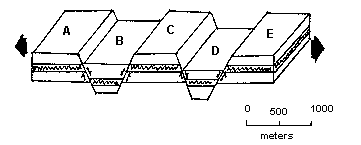|
| Fig. 2 :View from Barron Canyon area of the graben |
|
|
| http://www.mcelroy.ca/notes/graben.shtml. |
Definition of a graben from Webster's Online Dictionary: n. "A down-dropped
block of the earth's crust resulting from extension, or pulling, of the crust." (Parker, 2008).
Now that we have a general idea of what a graben is, our next question is "How is it formed?"
This is a rather interesting answer. Since we know that the earth is comprised of gigantic plates which move in all
directions, we know that the formation of grabens has to do with these plate tectonics. When these plates diverge
(move apart) from each other, they stretch the continental crust. The thinned, stretched crust forms a graben,
which is somewhat like a valley in the sense that it is a piece of land that is significantly lower than the two blocks
of land on each side. These lowered blocks of land can fill with sediment or with water over time to create rivers
and lakes. Grabens are also referred to as Rift Valleys.
There are also blocks of land that are pushed upwards, creating a horst, the opposite
of a graben. In the figure below, Blocks A, C and E are what we call horsts, and Blocke B and D are grabens.
| Fig. 3: Diagram of Horsts vs. Grabens |

|
| www.gpc.edu/~janderso/images/h&g.gif |
How do we know the continents and plates broke apart?
Over the decades, geologists and scientists have discovered
similar plants, animals and mountain ranges that continue on different continents with oceans between them. the following
illustration shows similar dinosaur fossils in different areas of the world.
| Fig.4: Paleantological evidence of plate tectonics |
|
|
| Image from: (Plummer, Charles C. et.al. 2007) |
For more information on fault lines and the movements of plates check this out:
FAULTS
|

